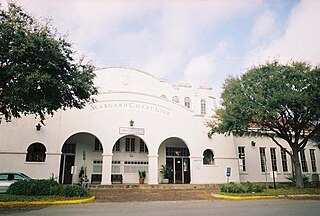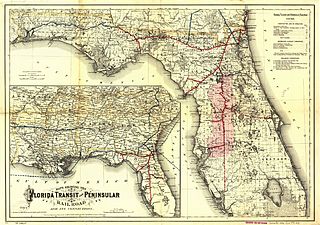Gallery
- Fort Myers Station
- Wilson Station
- Selma Union Depot
- Sarasota Depot site historical marker
- Orlando Station
- Lettering of the Orlando station
Alpheus Marston Griffin, [1] (1885-1954) was an American architect who worked as a staff architect for the Atlantic Coast Line Railroad in the 1920s.
Griffin was educated at Peabody College. He worked as an architect for the Nashville Interurban Railway beginning in 1908, then as an assistant engineer, assistant architect, and finally architect for the Nashville, Chattanooga & St. Louis Railway between 1909 and 1917. He served as a 1st Lieutenant of Engineers in the United States Army in 1918 and 1919. He then began working for the Atlantic Coast Line in December, 1919. [2] Griffin was a member of American Railway Association's Committee VI Buildings in 1921. [3] The railroad sent Griffin to the American southwest in the mid 1920s to study Spanish missions such as those in Santa Barbara and San Juan Capistrano before he designed the Mission Revival style stations in Sarasota and Orlando. [4] [5] Griffin designed each letter of the Orlando station sign. [6] At least three of the stations Griffin designed are listed on the National Register of Historic Places.
Griffin was born at Nashville, Tennessee, on March 2, 1885. He married Icie Pugh in 1908, and they had five children, Douglas Winston, Ice Ruth, Roberta, Elsie Carol, and Alpheus Jr. Griffin died August 6, 1954, in Nashville. [7]

The Atlantic Coast Line Railroad was a United States Class I railroad formed in 1900, though predecessor railroads had used the ACL brand since 1871. In 1967 it merged with long-time rival Seaboard Air Line Railroad to form the Seaboard Coast Line Railroad. Much of the original ACL network has been part of CSX Transportation since 1986.

Orlando Health/Amtrak station, also known as Orlando station, is a train station in Orlando, Florida. It is served by Amtrak, the national railroad passenger system of the United States, and SunRail, the commuter rail service of Greater Orlando, as well as local and intercity buses. It serves Amtrak's Silver Meteor and Silver Star lines. Built in 1926, the historic station is located approximately one mile south of Downtown Orlando near the campus of Orlando Health. Serving 160,442 passengers at last measure in 2013, The station is Amtrak's fifth busiest in the Southeastern United States; it is the second busiest Amtrak station in Florida, behind the Sanford station of the Auto Train.

Mediterranean Revival is an architectural style introduced in the United States, Canada, and certain other countries in the 19th century. It incorporated references from Spanish Renaissance, Spanish Colonial, Italian Renaissance, French Colonial, Beaux-Arts, Moorish architecture, and Venetian Gothic architecture.

The Florida Central and Peninsular Railroad was the final name of a system of railroads throughout Florida, becoming part of the Seaboard Air Line Railway in 1900. The system, including some of the first railroads in Florida, stretched from Jacksonville west through Tallahassee and south to Tampa. Much of the FC&P network is still in service under the ownership of CSX Transportation.

The Atlantic Coast Line Passenger Depot was a historic Atlantic Coast Line Railroad depot in Sarasota, Florida, United States. It was located at 1 South School Avenue.

Selma Union Depot, also known as Selma Union Station, is a train station and museum in Selma, North Carolina. Built in 1924, it is currently served by two Amtrak passenger trains, the Palmetto and the Carolinian. It is located at 500 East Railroad Street in the heart of downtown Selma. The Silver Meteor and the Silver Star have their northern split here, but do not stop in Selma.

Palatka station is a historic train station that was built in Palatka, Florida in 1908. The station currently serves Amtrak's Silver Service line and also houses the Palatka Railroad Preservation Society and the David Browning Railroad Museum. It is located at 220 North Eleventh Street, at the corner of North Eleventh Street's intersection with US 17/SR 100.
The Atlantic Coast Line Railroad was a US Class I railroad from 1900 until 1967. The following former and active train stations were previously used by the Atlantic Coast Line Railroad. Many of them are listed on the National Register of Historic Places.
The Seaboard Air Line Depot can refer to the following former and active train stations previously used by the Seaboard Air Line Railroad, many of which are listed on the National Register of Historic Places:

The Champion was a streamlined passenger train operated by the Atlantic Coast Line Railroad and Florida East Coast Railway between New York City and Miami or St. Petersburg, Florida. It operated from 1939 until 1979, continuing under the Seaboard Coast Line and Amtrak. It was a direct competitor to the Seaboard Air Line Railway's Silver Meteor, the first New York-Florida streamliner.
Atlantic Coast Line Railroad Depot or Atlantic Coast Line Depot may refer to:

Myrtle Beach Atlantic Coast Line Railroad Depot is a historic train station located at Myrtle Beach in Horry County, South Carolina. It was built in 1937 by the Atlantic Coast Line Railroad, and is one-story rectangular building was constructed with the standard ACL bi-level floor plan that has a raised freight room with steps leading down to the lobby/office area. It features exterior architectural detailing reflecting Colonial Revival, Craftsman, and Mission stylistic influences.

The Dixie Flagler was a streamlined passenger train operated by the Florida East Coast Railway (FEC) between Chicago, Illinois and Miami, Florida. It began in 1939 as the Henry M. Flagler, a regional service between Miami and Jacksonville, Florida; the FEC renamed it and extended it to Chicago a year later. It was one of the few Chicago to Florida trains that passed through Atlanta. As an overnight streamliner it was part of the every-third-day pool shared by the City of Miami and South Wind. It was renamed Dixieland in 1954 and discontinued altogether in 1957.
The Tampa Southern Railroad was a subsidiary of the Atlantic Coast Line Railroad (ACL) originally running from Uceta Yard in Tampa south to Palmetto, Bradenton, and Sarasota with a later extension southeast to Fort Ogden in the Peace River valley built shortly after. It was one of many rail lines completed during the Florida land boom of the 1920s. Most of the remaining trackage now serves as CSX Transportation's Palmetto Subdivision. Another short portion just east of Sarasota also remains that is now operated by Seminole Gulf Railway.

Union Station, also known as Atlantic Coast Line Railroad and Southern Railway Station, is a historic train station located at Columbia, South Carolina. It was built in 1902, and is a brick and stone, eclectic Jacobethan Revival / Tudor Revival building. It features stepped gables and towering chimneys. It was designed by architect Frank Pierce Milburn for the Atlantic Coast Line Railroad and Southern Railway. In contrast to the custom of 'union station' denoting the single station for several railroads, the Seaboard Air Line Railroad had its own station one-half mile away. The formerly Seaboard Silver Star still operates through another station in Columbia.

The Dixie Flyer was a premier named passenger train that operated from 1892 to 1965 via the "Dixie Route" from Chicago and St. Louis via Evansville, Nashville, and Atlanta to Florida. However, the train persisted to 1969 as an Atlanta to Florida operation, solely run by the Atlantic Coast Line Railroad and its successor. The Flyer's route varied in early years, but by about 1920 was set as follows:
Samuel L. Bartlett was an American architect who worked in Saint Paul, Minnesota, in the early 1900s. He was appointed to the position of architect with the Great Northern Railway in 1905. Bartlett was tasked to bring to reality the vision of Great Northern President Louis W. Hill for great destination hotels in the newly created Glacier National Park (U.S.). Several of the lodges and stations Bartlett designed for the Great Northern are listed in the National Register of Historic Places.
John H. Christie (1878–1960) was an American architect who worked for the Southern Pacific Railroad, and was the railroad's Chief Architect from 1924 to 1947.
E. M. Tucker was an American architect of St. Louis, Missouri, who worked for the Missouri Pacific Railroad.
The Flamingo was a passenger night train operated by the Louisville and Nashville Railroad.